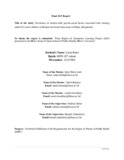| dc.contributor.advisor | Naher, Nahitun | |
| dc.contributor.advisor | Chakraborty, Barnali | |
| dc.contributor.author | Baroi, Liton | |
| dc.date.accessioned | 2023-07-13T09:34:12Z | |
| dc.date.available | 2023-07-13T09:34:12Z | |
| dc.date.copyright | 2023 | |
| dc.date.issued | 2023 | |
| dc.identifier.other | ID 22167004 | |
| dc.identifier.uri | http://hdl.handle.net/10361/18813 | |
| dc.description | This project report is submitted in partial fulfillment of the requirements for the degree of Master of Public Health (MPH), 2023. | en_US |
| dc.description | Cataloged from the PDF version of the project report. | |
| dc.description | Includes bibliographical references (pages 27-29). | |
| dc.description.abstract | Background: Stunting, an indicator of regional linear growth, has become a key biomarker of
childhood undernutrition due to its continuing elevated incidence worldwide and significance for
overall development and well-being. Most analyses have largely ignored psychological problems
influencing care and nurturing in the home in favor of social and biological aspects. This study to
document the prevalence of stunting as well as mothers-child psycho-social contributing
variables
Methods: A quantitative approach and community-based cross-sectional study were made
among 390 children between the age of six months and under five years old in the dholpur and
korail slum areas in Dhaka, Bangladesh. Anthropometric measurements of the child were done
using standard methods [version 3.2.2 (Z-score)]. STATA SE 17 version was used to analyze the
data. A chi-square test was performed to compare the differences and significance between the
outcome and independent variables. For the chi test, the significant value was calculated as
p-value <0.05. This study performed univariate and multivariate logistic regression analysis to
evaluate the association between independent factors (mothers-child psycho-social factors) and
the outcome variable (stunting).
Findings: The overall prevalence of stunting under five years of children was 36.15%. This
study had a statistically significant association between socio-demographic factors (husband's
educational level, husband's occupational level, child sex, and child age) and stunting. It was
revealed that those who felt loneliness during pregnancy had 1.3 higher odds of stunting than
those who never thought it. This study also explored those who had anxiety during pregnancy
had 1.6 higher odds of stunting than those with no anxiety. The study also reported that in the
case of child interaction problems with a neighbor child, who had interaction problems with
another child had 2.0 times higher odds of stunting than those with no interaction problems with
another child.
Conclusion: Though there was no statistically significant association between the mother -child
psycho-social problems and stunting, the study's prevalence was high. It would be helpful to
undertake more studies to evaluate mother -child psycho-social factors in two urban slums and
compare them to other slums in the country. | en_US |
| dc.description.statementofresponsibility | Liton Baroi | |
| dc.format.extent | 55 pages | |
| dc.language.iso | en | en_US |
| dc.publisher | Brac University | en_US |
| dc.rights | Brac University project reports are protected by copyright. They may be viewed from this source for any purpose, but reproduction or distribution in any format is prohibited without written permission. | |
| dc.subject | Stunted | en_US |
| dc.subject | Psycho-social problem | en_US |
| dc.subject | Univariate & multivariate logistic regression | en_US |
| dc.subject.lcsh | Poor women--Health and hygiene | |
| dc.title | Prevalence & mother-child psycho-social factors associated with stunting under five years children at Dholpur and Korail slum areas in Dhaka, Bangladesh | en_US |
| dc.type | Project report | en_US |
| dc.contributor.department | James P Grant School of Public Health, Brac University | |
| dc.description.degree | M. Public Health | |

